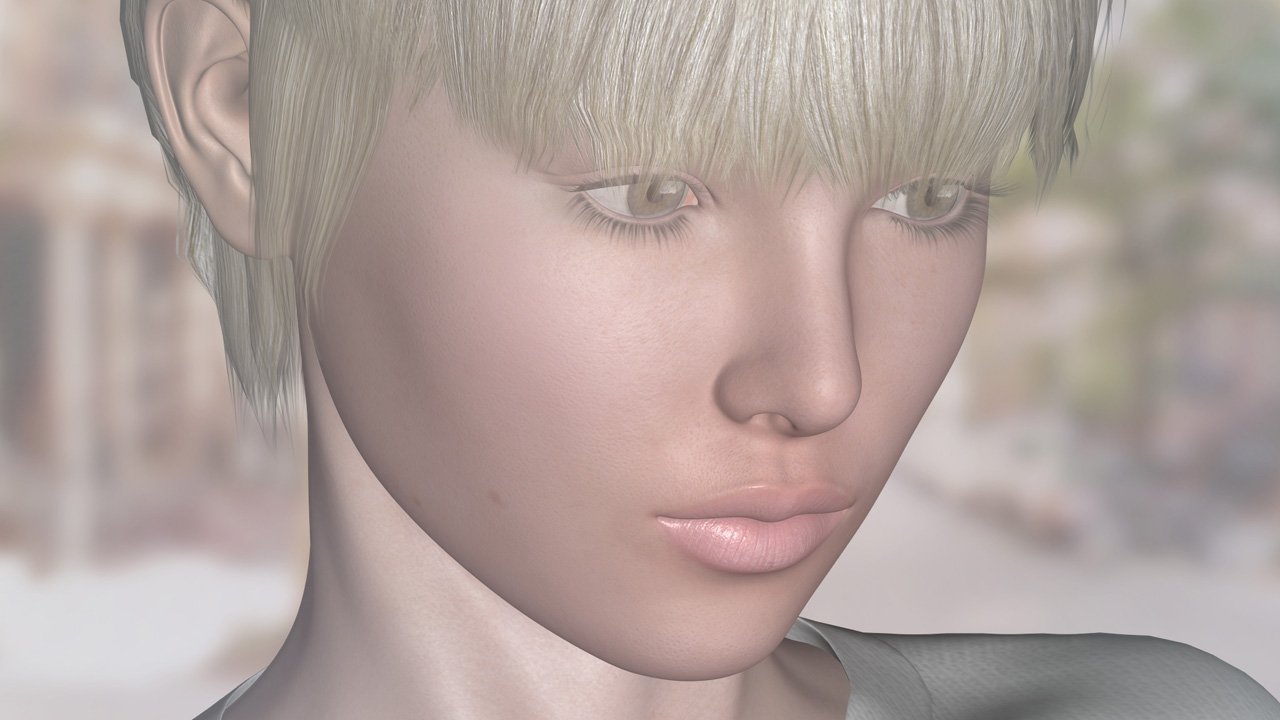You probably haven’t run into the artist LaTurbo Avedon at a new media gallery opening or bummed a cigarette outside “the club.” She has a shock of bright blonde hair recently shaved down to that undercut that’s so popular at the moment, misty hazel eyes, and porcelain skin, plus a hyperactive social media presence to rival Ryder Ripps. The difference between Avedon and other media-embedded net artists is that she doesn’t actually exist in your physical world.
LaTurbo Avedon is a virtual character, a fiction that lives and breathes online. When I interviewed her for this profile (over Gchat, naturally), she described her origins enigmatically: “You could probably say I was born in the character creation screen of a video game, or in a create-new-user field for a new email address.” In other words, she’s an immaculate digital conception.
Avedon’s projects run from club remixes that she posts online to videos of her avatar dancing in surreal virtual chambers designed from the remains of historical artworks — see “Club Rothko.” Avedon’s ongoing series of “New Sculpts” are jagged digital constructions made from image files turned into three-dimensional mesh. Inspired by modernist painters like Jean Metzinger and El Lissitzky, the works combine art history with contemporary CGI aesthetics. “Last year I spent a lot of time using a borrowed ArtStor login and playing Mass Effect, and I suppose I wanted to meet somewhere in the middle,” she explained.

The “New Sculpts” are the backbone of Avedon’s upcoming exhibition at Bushwick’s Transfer gallery, opening this Saturday, July 20th. In the show, the images will be printed large-scale on vinyl, the same material that stretches across billboards. One print will stretch floor to ceiling to cut the space in half, a first for the young gallery, according to Transfer co-founder Kelani Nichole. Avedon will also be in attendance at the opening. How, you might ask? The possibilities include a performance in the MMORPG Second Life or an interactive chat.

“As you can imagine it is not easy coordinating a physical exhibition when you’re not able to be there,” Avedon said. To remedy this, the artist worked with Nichole to create a scaled rendering of the gallery and designed her installations there. The process was “quite schematic,” Avedon noted, but it’s actually not so different from how many non-virtual artists work with exhibitions—these days, we all exist virtually.
Yet Avedon takes extra care to preserve her anonymity. Hence her decision to sell the Transfer gallery work via Bitcoin, a digital crypto-currency that’s more often used to buy drugs and weapons than paintings. The artist used Bitcoin to pay for the show’s printing costs. “It was an ideal and private means to arrange for the exports of the work,” Avedon said.
 A virtual artist uses virtual currency. The choice suits Avedon’s precarious existence. “The successes or failures of Bitcoin are uncertain, just as mine are,” the artist told me. The currency also makes a good comparison for the instability of the art market itself, driven as it is by the tastes of curators and collectors. “Bitcoin’s valuation is so volatile; the implication on the artwork is that one day it could be worth a lot more than the next,” Transfer’s Kelani Nichole said.
A virtual artist uses virtual currency. The choice suits Avedon’s precarious existence. “The successes or failures of Bitcoin are uncertain, just as mine are,” the artist told me. The currency also makes a good comparison for the instability of the art market itself, driven as it is by the tastes of curators and collectors. “Bitcoin’s valuation is so volatile; the implication on the artwork is that one day it could be worth a lot more than the next,” Transfer’s Kelani Nichole said.
Such uncertainty can be scary, particularly to art patrons unused to digital work. But have no fear. “If collectors are interested in collecting but squeamish about Bitcoin, we will facilitate a transaction on their behalf,” Nichole assured me.
The artist, however, will still stay virtual.



